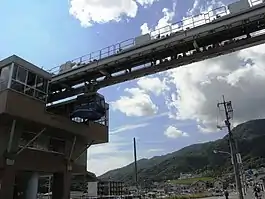| Skyrail Midorizaka Line | ||||||||||||||||||||||||||||||||||||||||||||||||
|---|---|---|---|---|---|---|---|---|---|---|---|---|---|---|---|---|---|---|---|---|---|---|---|---|---|---|---|---|---|---|---|---|---|---|---|---|---|---|---|---|---|---|---|---|---|---|---|---|
 | ||||||||||||||||||||||||||||||||||||||||||||||||
| Overview | ||||||||||||||||||||||||||||||||||||||||||||||||
| Other name(s) | Hiroshima Short Distance Transit Seno Line | |||||||||||||||||||||||||||||||||||||||||||||||
| Native name | スカイレールみどり坂線 (広島短距離交通瀬野線) | |||||||||||||||||||||||||||||||||||||||||||||||
| Stations | 3 | |||||||||||||||||||||||||||||||||||||||||||||||
| Service | ||||||||||||||||||||||||||||||||||||||||||||||||
| Type | Suspended monorail | |||||||||||||||||||||||||||||||||||||||||||||||
| Operator(s) | Skyrail Service (スカイレールサービス) | |||||||||||||||||||||||||||||||||||||||||||||||
| Rolling stock | 200 series | |||||||||||||||||||||||||||||||||||||||||||||||
| History | ||||||||||||||||||||||||||||||||||||||||||||||||
| Opened | 28 August 1998 | |||||||||||||||||||||||||||||||||||||||||||||||
| Closed | April 2024 (planned) | |||||||||||||||||||||||||||||||||||||||||||||||
| Technical | ||||||||||||||||||||||||||||||||||||||||||||||||
| Line length | 1.3 km (0.81 mi) | |||||||||||||||||||||||||||||||||||||||||||||||
| Number of tracks | 2 | |||||||||||||||||||||||||||||||||||||||||||||||
| Character | Elevated | |||||||||||||||||||||||||||||||||||||||||||||||
| Electrification | 440 V DC | |||||||||||||||||||||||||||||||||||||||||||||||
| Signalling | Linear motor | |||||||||||||||||||||||||||||||||||||||||||||||
| Highest elevation | 160 m (520 ft) | |||||||||||||||||||||||||||||||||||||||||||||||
| ||||||||||||||||||||||||||||||||||||||||||||||||

The Skyrail Midorizaka Line (スカイレールみどり坂線, Sukairēru Midorizaka-sen) is a monorail/people mover line operated by Skyrail Service. The line runs between Midoriguchi and Midori-Chūō, all within the new town called Skyrail Town Midorizaka, Aki, Hiroshima, Hiroshima, Japan. The line is officially called Hiroshima Short Distance Transit Seno Line (広島短距離交通瀬野線, Hiroshima Tankyori Kōtsū Seno-sen). The line is also known as the first Japanese public transport to introduce a smart card, simply called IC Commuter Pass (IC定期券, Aishī Teikiken), from the time the line itself opened on August 28, 1998.[1]
History
The line opened on 28 August 1998, with a total construction cost of approximately ¥6.2 billion.[2]
The operators of the line announced on 5 November 2022 that the line would be closed by the end of 2023 due to profitability concerns, with it being replaced by electric buses.[3] The closure has been postponed to April 2024.[4]
Technology
The line uses a new "Skyrail" rail transport system developed mainly by Kobe Steel and Mitsubishi Heavy Industries. It is a fusion between a suspended monorail and an aerial lift. Driverless gondola-sized cars, suspended from a single steel track, are moved by an attached cable. Inside each station, cars release the cable and move by linear motors. The technology allows the line to climb steep slopes of up to 14 degrees, while also being able to navigate curves of up to 30m radius.[5]
Rolling stock
The entire line uses 200 series vehicles, which hold up to 25 people. The operating speed is 15 km/h.[5]
Services
The line operates from around 630am to 10pm, with cars running every 15 minutes during the midday, and every 5-10 minutes at other times. A night taxi runs afterwards until midnight.[6]
It takes five minutes to travel the whole length of the line. The fare is ¥170 for adults.[5]
Stations
All the stations on the line are elevated, with two side platforms serving two tracks.
| Name | Japanese | Coordinates | Distance (km) | Transfers | |
|---|---|---|---|---|---|
| Between stations | Total | ||||
| Midoriguchi | みどり口 | 34°25′19.9″N 132°35′46.8″E / 34.422194°N 132.596333°E | - | 0 | G Sanyo Main Line (Seno Station) |
| Midori-Nakamachi | みどり中街 | 34°25′40″N 132°35′42″E / 34.42778°N 132.59500°E | 0.7 | 0.7 | |
| Midori-Chūō | みどり中央 | 34°25′49″N 132°35′22″E / 34.43028°N 132.58944°E | 0.6 | 1.3 | |
 Midoriguchi station
Midoriguchi station Midori-Nakamachi station
Midori-Nakamachi station Midori-Chūō station
Midori-Chūō station
See also
References
- ↑ "進化する自動改札機、世界初の遅延証明も!". Toyo Keizai (in Japanese). 2015-01-02. Retrieved 2022-11-07.
- ↑ "新交通システム「スカイレール」運行開始". Ministry of Land, Infrastructure, Transport and Tourism. Retrieved 2022-11-07.
- ↑ "みどり坂のスカイレール、2023年末めどに運行終了へ JR瀬野駅と団地結ぶ交通システム【動画】". Chugoku Shimbun (in Japanese). 5 November 2022. Retrieved 2022-11-07.
- ↑ "スカイレール 運行終了を来年4月末に延期 広島". 14 June 2023. Retrieved 2023-08-23.
- 1 2 3 "日本唯一の交通システム「スカイレール」 見かけはロープウェイ、走行にリニアの技術". Traffic News (in Japanese). 11 September 2018. Retrieved 2022-11-07.
- ↑ "スカイレール・ジャンボタクシー". Sekisui House. 2016-11-10. Archived from the original on 2016-11-10. Retrieved 2022-11-07.
External links
- (in Japanese) Intra-city transport system: Skyrail, from Kobe Steel official website.
- Video on YouTube